Related Research Articles

Kanishka I, or Kanishka the Great, an emperor of the Kushan dynasty in the second century, is famous for his military, political, and spiritual achievements. A descendant of Kujula Kadphises, founder of the Kushan empire, Kanishka came to rule an empire in Bactria extending to Pataliputra on the Gangetic plain. The main capital of his empire was located at Puruṣapura in Gandhara, with another major capital at Kapisa.
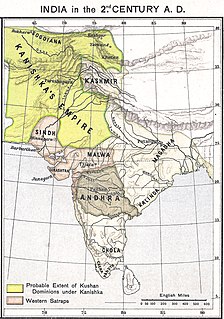
The Kushan Empire was a syncretic empire, formed by the Yuezhi, in the Bactrian territories in the early 1st century. It spread to encompass much of modern-day territory of Afghanistan, Pakistan and northern India, at least as far as Saketa and Sarnath near Varanasi (Benares), where inscriptions have been found dating to the era of the Kushan Emperor Kanishka the Great. The founder of the dynasty, Kujula Kadphises, followed Greek religious ideas and iconography after the Greco-Bactrian tradition, but was also a devotee of the Hindu God Shiva, an almost historical necessity due to the presence of Indian culture and traders on the Silk Road. The Kushans in general were also great patrons of Buddhism, and, starting with Emperor Kanishka, they also employed elements of Zoroastrianism in their pantheon. They played an important role in the spread of Buddhism to Central Asia and China.

Kujula Kadphises was a Kushan prince who united the Yuezhi confederation during the 1st century CE, and became the first Kushan emperor. According to the Rabatak inscription, he was the great grandfather of the great Kushan king Kanishka I. He is considered the founder of the Kushan Empire.

Kanishka II was one of the emperors of the Kushan Empire from around 225–245 CE. He succeeded Vasudeva I who is considered to be the last great Kushan emperor.

Vima Kadphises, was a Kushan emperor from approximately 90–100 CE. According to the Rabatak inscription, he was the son of Vima Takto and the father of Kanishka.

Vima Takto or Vima Taktu was a Kushan emperor who reigned c. 80–90 CE.

Huvishka was the emperor of the Kushan Empire from the death of Kanishka until the succession of Vasudeva I about thirty years later.

Vāsudeva I was a Kushan emperor, last of the "Great Kushans." Named inscriptions dating from year 64 to 98 of Kanishka's era suggest his reign extended from at least 191 to 232 CE. He ruled in northern India and central asia and still minted in coins in Balkh (Bactria) as well, although he probably had to deal with the rise of the Sasanians and the first incursions of the Kushano-Sasanians in the northwest of his territory.

Vasudeva II was a Kushan emperor who ruled c. 275–300 CE. He was probably the successor of Kanishka III and may have been succeeded by a king named Shaka Kushan.

Kanishka III, was a Kushan emperor who reigned for a short period around the year 268 CE. He is believed to have succeeded Vasishka and was succeeded by Vasudeva II. He ruled in areas of Northwestern India.
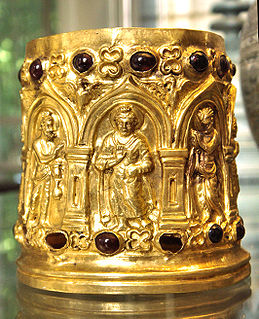
The Bimaran casket or Bimaran reliquary is a small gold reliquary for Buddhist relics that was found inside the stupa no.2 at Bimaran, near Jalalabad in eastern Afghanistan.
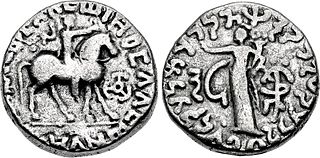
Kharahostes or Kharaostasa was an Indo-Scythian ruler in the northern Indian subcontinent around 10 BC – 10 AD. He is known from his coins, often in the name of Azes II, and possibly from an inscription on the Mathura lion capital, although another satrap Kharaostes has been discovered in Mathura.

Mujatria, previously read Hajatria, is the name of an Indo-Scythian ruler, the son of Kharahostes as mentioned on his coins.
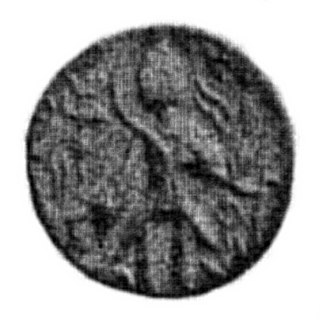
Chhu seems to have been a late Kushan Empire ruler, who ruled from 310 to 325 CE. His coinage is very similar to that of his near-contemporary Vasudeva. His rule corresponds to the last days of the Kushan Empire, before the conquest by Kidara.
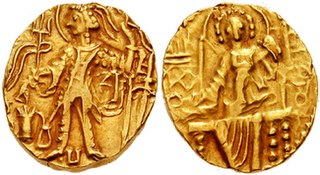
Vasudeva III was possibly the son of Vasudeva II and a ruler of the Kushan Empire c. 360-365 CE.
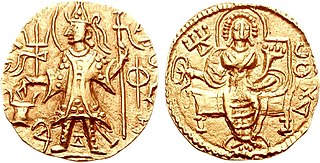
Vāsishka was a Kushan emperor, who seems to have had a short reign following Kanishka II.

Shaka may have been one of the last rulers of the Kushan Empire around 325-345. He may have succeeded Vasudeva II. There is a group of Kushan gold coins that all carry the Brahmi legend Shaka in the right field, in the same place where Vasudeva II's coins read Vasu, so it is natural to suppose that perhaps Shaka was the name of the king who issued these coins. A further support for this idea is that there is a mention of one "Devaputra Shahi Shahanshahi Shaka Murunda" in Samudragupta's famous Allahabad inscription, as one of the rulers who paid him homage. In this context, Shaka could be a title, it could refer to a tribe, or it could be a personal name. In any case, it seems to be related to the Shaka coins. Unfortunately, we don't know the date of the Allahabad inscription, so the best guess on dating Shaka is c. mid-4th century.

Kipunada, also Kipanadha, was probably the last ruler of the Kushan Empire around 335-350 CE. He is known for his gold coinage. He succeeded Shaka I. Kipunada was probably only a local ruler in the area of Taxila, in western Punjab, and he may have been a subject of Gupta Emperor Samudragupta.
Vasudeva V, or Vasudeva of Kabul was a Kushan ruler circa 300 CE. He was the possible child of Vasudeva IV, ruling in Kabul. His existence is uncertain.

Mahi was a Kushan ruler, whose reign is dated to circa 300-305 CE. He probably succeeded Vasudeva II, and his successor was Shaka. Mahi was among the last Kushan Emperors, before they were overrun by the Kidarites.
References
This article needs additional citations for verification .(January 2021) (Learn how and when to remove this template message) |
- ↑ Raj Kumar (2010). Early history of Jammu region. Gyan Publishing House. p. 477. ISBN 978-81-7835-770-6.
- ↑ From the dated inscription on the Rukhana reliquary
- ↑ An Inscribed Silver Buddhist Reliquary of the Time of King Kharaosta and Prince Indravarman, Richard Salomon, Journal of the American Oriental Society, Vol. 116, No. 3 (Jul. - Sep., 1996), pp. 442
- ↑ A Kharosthī Reliquary Inscription of the Time of the Apraca Prince Visnuvarma, by Richard Salomon, South Asian Studies 11 1995, Pages 27-32, Published online: 09 Aug 2010
- 1 2 3 4 5 6 7 8 9 10 11 12 13 Cribb, Joe; Donovan, Peter (2014). Kushan, Kushano-Sasanian, and Kidarite Coins A Catalogue of Coins From the American Numismatic Society by David Jongeward and Joe Cribb with Peter Donovan. p. 4.
| | This biography of a member of an Asian royal house is a stub. You can help Wikipedia by expanding it. |